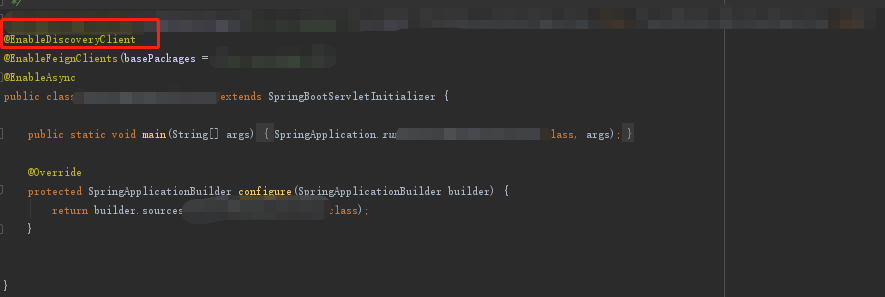这篇我们来对Eureka客户端的源码做一个分析。
首先我们我们可以看平时的一个使用场景,见如下的图:

那么这个EnableDiscoveryClient的注解是在哪里实现的呢?
首先需要解释的是,这个其实是springboot的AutoConfigration的一种特性,即无需我们以前那种大量xml配置文件的配置形式。目前大家所看到的很多starter也是使用此方式来实现。我们快速看一下spring.factories中的信息(这里面会涉及到部分的springboot的基础知识,如果不太熟悉的需要自行去学习),我们可以看到里面有一个类:org.springframework.cloud.netflix.eureka.EurekaDiscoveryClientConfiguration,如下是此类中部分的代码:
@Configuration
@ConditionalOnClass(RefreshScopeRefreshedEvent.class)
protected static class EurekaClientConfigurationRefresher
implements ApplicationListener<RefreshScopeRefreshedEvent> {
@Autowired(required = false)
private EurekaClient eurekaClient;
@Autowired(required = false)
private EurekaAutoServiceRegistration autoRegistration;
public void onApplicationEvent(RefreshScopeRefreshedEvent event) {
// This will force the creation of the EurkaClient bean if not already created
// to make sure the client will be reregistered after a refresh event
if (eurekaClient != null) {
eurekaClient.getApplications();
}
if (autoRegistration != null) {
// register in case meta data changed
this.autoRegistration.stop();
this.autoRegistration.start();
}
}
}
从以上代码我们可以知道,我们可以看到其会随着spring容器初始化,而进行客户端的调用过程,调用的方式为:eurekaClient.getApplications()。所以这下我们就可以去重点分析一下Eureka中客户端的源码情况了。
通过代码我们看到,EurekaClient是一个接口,其继承自LookupService接口,而实现EurekaClient的实现类为:DiscoveryClient,接下来我们分析下此类中的几个核心的流程,如下的代码都是摘取的部分核心功能,对全部流程感兴趣的可以自行下载Eureka的源码进行分析。
//..........
scheduler = Executors.newScheduledThreadPool(2,
new ThreadFactoryBuilder()
.setNameFormat("DiscoveryClient-%d")
.setDaemon(true)
.build());
heartbeatExecutor = new ThreadPoolExecutor(
1, clientConfig.getHeartbeatExecutorThreadPoolSize(), 0, TimeUnit.SECONDS,
new SynchronousQueue<Runnable>(),
new ThreadFactoryBuilder()
.setNameFormat("DiscoveryClient-HeartbeatExecutor-%d")
.setDaemon(true)
.build()
);
cacheRefreshExecutor = new ThreadPoolExecutor(
1, clientConfig.getCacheRefreshExecutorThreadPoolSize(), 0, TimeUnit.SECONDS,
new SynchronousQueue<Runnable>(),
new ThreadFactoryBuilder()
.setNameFormat("DiscoveryClient-CacheRefreshExecutor-%d")
.setDaemon(true)
.build()
);
eurekaTransport = new EurekaTransport();
scheduleServerEndpointTask(eurekaTransport, args);
//...........
initScheduledTasks();
以上代码进行了如下的一些初始化的工作:
1、生成一个统一的调度器Scheduler;
2、创建一个心跳检测的线程池;
2、创建一个任务缓存更新的线程池;
3、创建Eureka客户端与服务端通信的传输器;
4、开启与Server端的通信管道;
5、设置并开启心跳检测、任务本地缓存更新的定时任务。
我们先看一下心跳检测的过程。
客户端对服务端的心跳检测,也叫做”续约(renew)“的一个过程。其根据客户端或者默认的90s时间定时周期性地进行心跳检测操作。如下是代码的实现分析:
boolean renew() {
EurekaHttpResponse<InstanceInfo> httpResponse;
try {
httpResponse = eurekaTransport.registrationClient.sendHeartBeat(instanceInfo.getAppName(), instanceInfo.getId(), instanceInfo, null);
logger.debug(PREFIX + "{} - Heartbeat status: {}", appPathIdentifier, httpResponse.getStatusCode());
if (httpResponse.getStatusCode() == Status.NOT_FOUND.getStatusCode()) {
REREGISTER_COUNTER.increment();
logger.info(PREFIX + "{} - Re-registering apps/{}", appPathIdentifier, instanceInfo.getAppName());
long timestamp = instanceInfo.setIsDirtyWithTime();
boolean success = register();
if (success) {
instanceInfo.unsetIsDirty(timestamp);
}
return success;
}
return httpResponse.getStatusCode() == Status.OK.getStatusCode();
} catch (Throwable e) {
logger.error(PREFIX + "{} - was unable to send heartbeat!", appPathIdentifier, e);
return false;
}
}
从如上的代码我们可以看到,客户端拿到本应用的实例信息通过Eureka与服务端的交互管道进行heatbeat通讯。
会包括如下的流程:
1、如果接收到心跳的返回状态是OK的话,那么就代表心跳交互成功;
2、如果服务端返回的状态码是”NOT_FOUND“,那么会进行一个服务注册的过程。服务注册的过程见如下的代码:
boolean register() throws Throwable {
logger.info(PREFIX + "{}: registering service...", appPathIdentifier);
EurekaHttpResponse<Void> httpResponse;
try {
httpResponse = eurekaTransport.registrationClient.register(instanceInfo);
} catch (Exception e) {
logger.warn(PREFIX + "{} - registration failed {}", appPathIdentifier, e.getMessage(), e);
throw e;
}
if (logger.isInfoEnabled()) {
logger.info(PREFIX + "{} - registration status: {}", appPathIdentifier, httpResponse.getStatusCode());
}
return httpResponse.getStatusCode() == Status.NO_CONTENT.getStatusCode();
}
从以上的代码可以看出,整个注册的过程也是走的Eureka客户端与服务端专门的交互管道。
我们再看一下客户端服务信息本地缓存更新的方法说明。
void refreshRegistry() {
try {
//........
boolean success = fetchRegistry(remoteRegionsModified);
if (success) {
registrySize = localRegionApps.get().size();
lastSuccessfulRegistryFetchTimestamp = System.currentTimeMillis();
}
} catch (Throwable e) {
logger.error("Cannot fetch registry from server", e);
}
}
以上代码是缓存更新的核心的代码,主要做的工作就是获取注册中心的服务的信息。如下是获取的详细的过程。
private boolean fetchRegistry(boolean forceFullRegistryFetch) {
Stopwatch tracer = FETCH_REGISTRY_TIMER.start();
try {
Applications applications = getApplications();
if (clientConfig.shouldDisableDelta()
|| (!Strings.isNullOrEmpty(clientConfig.getRegistryRefreshSingleVipAddress()))
|| forceFullRegistryFetch
|| (applications == null)
|| (applications.getRegisteredApplications().size() == 0)
|| (applications.getVersion() == -1)) //Client application does not have latest library supporting delta
{
getAndStoreFullRegistry();
} else {
getAndUpdateDelta(applications);
}
applications.setAppsHashCode(applications.getReconcileHashCode());
} catch (Throwable e) {
return false;
} finally {
if (tracer != null) {
tracer.stop();
}
}
onCacheRefreshed();
updateInstanceRemoteStatus();
return true;
}
首先getApplications()获取客户端本地缓存的所有的服务信息,接下来分为两个过程,我的理解其实就是做增量更新还是全量更新的操作。
先看全量更新getAndStoreFullRegistry()。代码如下:
private void getAndStoreFullRegistry() throws Throwable {
long currentUpdateGeneration = fetchRegistryGeneration.get();
logger.info("Getting all instance registry info from the eureka server");
Applications apps = null;
EurekaHttpResponse<Applications> httpResponse = clientConfig.getRegistryRefreshSingleVipAddress() == null
? eurekaTransport.queryClient.getApplications(remoteRegionsRef.get())
: eurekaTransport.queryClient.getVip(clientConfig.getRegistryRefreshSingleVipAddress(), remoteRegionsRef.get());
if (httpResponse.getStatusCode() == Status.OK.getStatusCode()) {
apps = httpResponse.getEntity();
}
logger.info("The response status is {}", httpResponse.getStatusCode());
if (apps == null) {
logger.error("The application is null for some reason. Not storing this information");
} else if (fetchRegistryGeneration.compareAndSet(currentUpdateGeneration, currentUpdateGeneration + 1)) {
localRegionApps.set(this.filterAndShuffle(apps));
logger.debug("Got full registry with apps hashcode {}", apps.getAppsHashCode());
} else {
logger.warn("Not updating applications as another thread is updating it already");
}
}
一共有两种获取的方式,如果客户端配置的是以VIP的方式,则通过VIP的方式获取;否则就根据普通的方式获取。
获取成功之后会更新全局的Applications服务实例信息。
接下来再看一下getAndUpdateDelta(applications)增量的过程,代码如下:
private void getAndUpdateDelta(Applications applications) throws Throwable {
long currentUpdateGeneration = fetchRegistryGeneration.get();
Applications delta = null;
EurekaHttpResponse<Applications> httpResponse = eurekaTransport.queryClient.getDelta(remoteRegionsRef.get());
if (httpResponse.getStatusCode() == Status.OK.getStatusCode()) {
delta = httpResponse.getEntity();
}
if (delta == null) {
logger.warn("The server does not allow the delta revision to be applied because it is not safe. "
+ "Hence got the full registry.");
getAndStoreFullRegistry();
} else if (fetchRegistryGeneration.compareAndSet(currentUpdateGeneration, currentUpdateGeneration + 1)) {
logger.debug("Got delta update with apps hashcode {}", delta.getAppsHashCode());
String reconcileHashCode = "";
if (fetchRegistryUpdateLock.tryLock()) {
try {
updateDelta(delta);
reconcileHashCode = getReconcileHashCode(applications);
} finally {
fetchRegistryUpdateLock.unlock();
}
} else {
logger.warn("Cannot acquire update lock, aborting getAndUpdateDelta");
}
if (!reconcileHashCode.equals(delta.getAppsHashCode()) || clientConfig.shouldLogDeltaDiff()) {
reconcileAndLogDifference(delta, reconcileHashCode); // this makes a remoteCall
}
} else {
logger.warn("Not updating application delta as another thread is updating it already");
logger.debug("Ignoring delta update with apps hashcode {}, as another thread is updating it already", delta.getAppsHashCode());
}
}
从以上的代码我们大体可以分析出如下的一些执行过程:
首先获取服务增量的信息,如果获取的增量服务信息为空,则会进行全量的更新。
如果获取到服务的增量信息,则会进行增量更新的过程。
private void updateDelta(Applications delta) {
int deltaCount = 0;
for (Application app : delta.getRegisteredApplications()) {
for (InstanceInfo instance : app.getInstances()) {
Applications applications = getApplications();
String instanceRegion = instanceRegionChecker.getInstanceRegion(instance);
if (!instanceRegionChecker.isLocalRegion(instanceRegion)) {
Applications remoteApps = remoteRegionVsApps.get(instanceRegion);
if (null == remoteApps) {
remoteApps = new Applications();
remoteRegionVsApps.put(instanceRegion, remoteApps);
}
applications = remoteApps;
}
++deltaCount;
if (ActionType.ADDED.equals(instance.getActionType())) {
Application existingApp = applications.getRegisteredApplications(instance.getAppName());
if (existingApp == null) {
applications.addApplication(app);
}
logger.debug("Added instance {} to the existing apps in region {}", instance.getId(), instanceRegion);
applications.getRegisteredApplications(instance.getAppName()).addInstance(instance);
} else if (ActionType.MODIFIED.equals(instance.getActionType())) {
Application existingApp = applications.getRegisteredApplications(instance.getAppName());
if (existingApp == null) {
applications.addApplication(app);
}
logger.debug("Modified instance {} to the existing apps ", instance.getId());
applications.getRegisteredApplications(instance.getAppName()).addInstance(instance);
} else if (ActionType.DELETED.equals(instance.getActionType())) {
Application existingApp = applications.getRegisteredApplications(instance.getAppName());
if (existingApp != null) {
logger.debug("Deleted instance {} to the existing apps ", instance.getId());
existingApp.removeInstance(instance);
if (existingApp.getInstancesAsIsFromEureka().isEmpty()) {
applications.removeApplication(existingApp);
}
}
}
}
}
logger.debug("The total number of instances fetched by the delta processor : {}", deltaCount);
getApplications().setVersion(delta.getVersion());
getApplications().shuffleInstances(clientConfig.shouldFilterOnlyUpInstances());
for (Applications applications : remoteRegionVsApps.values()) {
applications.setVersion(delta.getVersion());
applications.shuffleInstances(clientConfig.shouldFilterOnlyUpInstances());
}
}
大体的原理是,每一个所注册的服务其实都会带一个ActionType的标识,会来标识这个服务是新增的,删除的,还是被修改过的。客户端根据这些标识进行对本地缓存做更新。
接下来onCacheRefreshed(),其主要功能就是输出通知缓存更新的通知。
最后一步,进行状态的更新。
private synchronized void updateInstanceRemoteStatus() {
// Determine this instance's status for this app and set to UNKNOWN if not found
InstanceInfo.InstanceStatus currentRemoteInstanceStatus = null;
if (instanceInfo.getAppName() != null) {
Application app = getApplication(instanceInfo.getAppName());
if (app != null) {
InstanceInfo remoteInstanceInfo = app.getByInstanceId(instanceInfo.getId());
if (remoteInstanceInfo != null) {
currentRemoteInstanceStatus = remoteInstanceInfo.getStatus();
}
}
}
if (currentRemoteInstanceStatus == null) {
currentRemoteInstanceStatus = InstanceInfo.InstanceStatus.UNKNOWN;
}
// Notify if status changed
if (lastRemoteInstanceStatus != currentRemoteInstanceStatus) {
onRemoteStatusChanged(lastRemoteInstanceStatus, currentRemoteInstanceStatus);
lastRemoteInstanceStatus = currentRemoteInstanceStatus;
}
}
首席按根据当前实例的名称获取远程服务的信息,接着在获取远程服务的状态,如果状态不为空,则将本地的服务状态进行变更;如果为空,则设置成UNKNOWN。
以上就是整个客户端的启动的过程分析。
—————–EOF——————